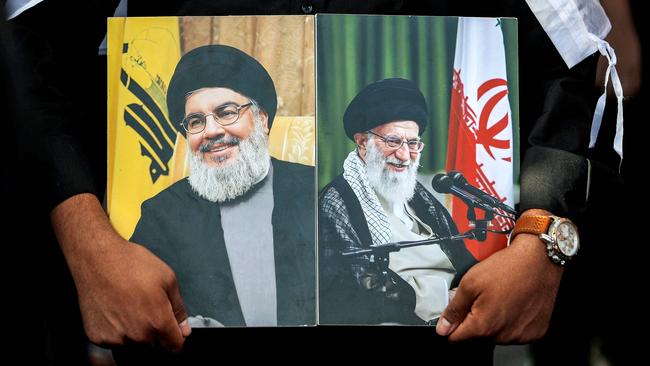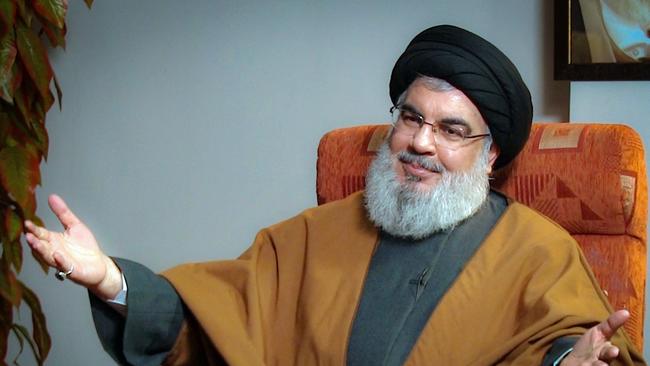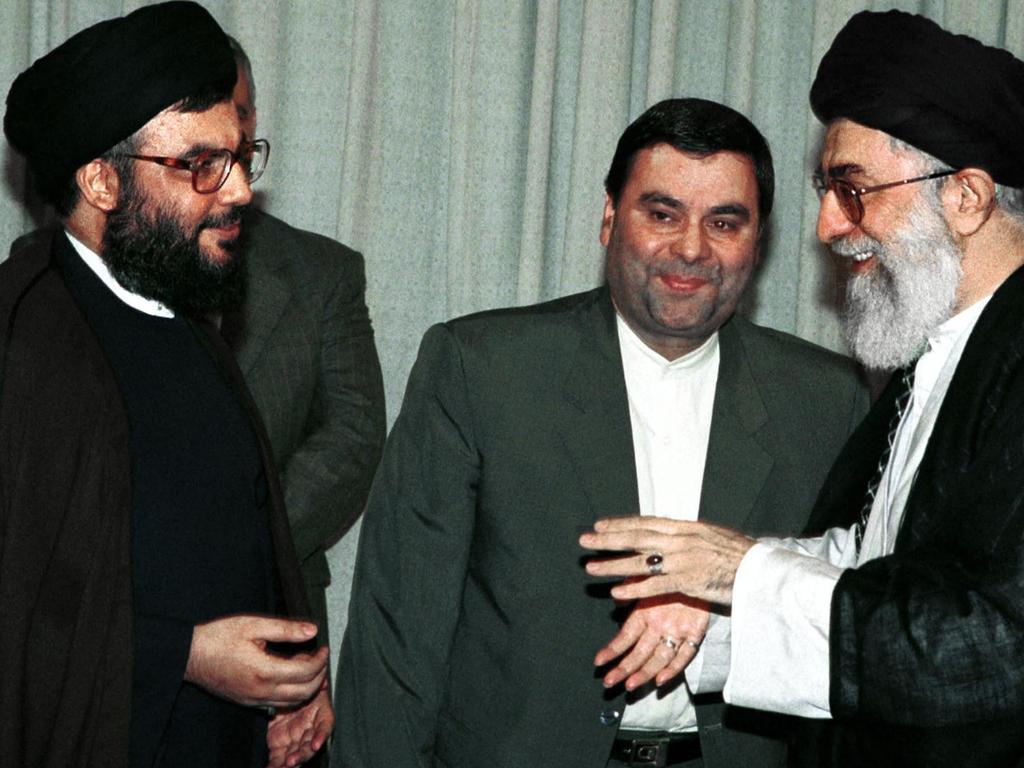Slain Hezbollah leader Hassan Nasrallah was Iran’s agent of influence in Arab world
The slain Hezbollah leader was Iran’s chief agent of influence in the whole of the Arab world and was seen by many Arabs as putting the interests of Iran before those of his own country.

As the leader of Lebanon’s Hezbollah terrorist group, Hassan Nasrallah was Iran’s chief agent of influence in the Arab world. He had risen rapidly from a junior commander in charge of kidnapped westerners in the mid-1980s to become the undisputed leader of one of the deadliest Islamist militias in the Middle East. By the time he was killed in an Israeli airstrike on Hezbollah’s headquarters in Beirut, he hadn’t been seen in public for many years.
The main element in his later success was total alignment with the wishes of Iran, particularly those of Ayatollah Ali Khamenei, the country’s supreme leader. This meant that when Hamas, another terrorist group that serves as a proxy for Iran, launched its murderous attack on Israel on October 7, 2023, killing about 1,200 people, mostly civilians, Hezbollah joined in the very next day, firing rockets into northern Israel in solidarity with Hamas. Hezbollah’s attacks continued over the following months forcing some 60,000 Israelis who lived near the border with Lebanon to leave their homes.

After the Shia cleric was appointed to the leadership of Hezbollah on the orders of Khamenei in 1992, Nasrallah sidelined all the other Lebanese Shia clerics who wished to be independent of Tehran or were close to Syria. As a result, Iran increased its aid to the organisation and made it the unofficial government of the southern half of Lebanon, where the writ of the official government ran in name only. As such, Nasrallah was Iran’s chief agent of influence in the whole of the Arab world and was seen by many Arabs as putting the interests of Iran before those of his own country.
Nevertheless, Hezbollah’s forcing of Israel to abandon the strip of border territory it had occupied for years made Nasrallah an Arab hero in 2000. In the end, his alignment with Iran brought the wrath of Israel on the head of Lebanon in July 2006, when the country’s economy was showing signs, at last, of having recovered from the devastation of the civil war of 1975-90.
The trigger for that catastrophe was Nasrallah’s decision, almost certainly with the prior approval of Tehran and Damascus, to mount a cross-border raid into Israel on July 12, to coincide with a summit of the G8 group of the most powerful nations in St Petersburg. His raiders succeeded in killing eight Israeli soldiers and abducting two more, followed by Hezbollah’s unleashing of an unprecedented barrage of medium-range missiles on the northern cities of Israel - aided by Iran’s recent shipment, through Syria, of short and medium-range missiles to Hezbollah. Thus the G8 meeting, which had planned to concentrate on the problem of how to prevent Iran from acquiring nuclear weapons, was forced to devote much of its time to the new crisis, for the ferocity of Israel’s response took the world by surprise.

The country’s air force began a systematic programme of destroying the economic infrastructure of southern Lebanon, including the southern districts of Beirut, Hezbollah’s power base. Up to a million Shias and others were forced to leave their homes. In addition, while the official government in Beirut, largely made up of ministers opposed to Iranian and Syrian interference, looked on in despair, Israel’s army entered the south again. Roads, bridges, ports and power stations were bombed and the summer tourist season, expected to earn the small country of four million people up to dollars 6 billion, came to a stop as hundreds of thousands of Arabs from the Persian Gulf cancelled their trips.
Western countries organised evacuations of their subjects - “the biggest since Dunkirk”, as one British minister described it - and dealt another blow to the country’s economic prospects. Above all, the Shias suffered. Being the poorest section of the population, it was, for them, the worst time of year to start a war. They had been preparing to gather in their wheat and tobacco harvests. Their vineyards and orchards of citrus and olive had to be abandoned.
Nasrallah never used the telephone for fear of assassination. On the rarest occasions when the Hezbollah leader granted an interview, journalists would be blindfolded before a long drive around the suburbs of southern Beirut. The man they were finally introduced to was rotund and jovial. Wearing the black turban of a sayyid, someone with a blood line that could be traced back to the Prophet Muhammad, he had played on this status to grow his popularity in the Arab world despite hailing from the minority Shia sect of Islam. Yet most Arab governments saw him largely as an instrument of Iranian foreign policy and used his lack of adequate preparations for dealing with Israel’s inevitable backlash to denounce him. Such normally reserved Arab states as Saudi Arabia described him as an “adventurer”. Even one of his own admirers in the Egyptian press came close to accusing him of treason. He said that although he liked the Hezbollah leader personally, he cared more for the blood of Lebanese children than he did for “pictures of Ayatollah Khamenei all over south Lebanon”.

The G8 leaders refused to call for an immediate ceasefire, letting it be seen as a green light to Israel to continue with its campaign to destroy Hezbollah or at least weaken it drastically for a number of years to give Lebanon a chance to disarm it according to Resolution 1559 of the United Nations security council two years earlier.
Hezbollah’s continued use of missiles against Israeli towns and villages, including, for the first time, the large port of Haifa, alienated much of the rest of the world. Nasrallah apologised for causing the deaths of several Arab children in Nazareth and elsewhere, but not for those of Jewish civilians.
Hassan Nasrallah was born in a poor district of Beirut in 1960. His father, Abdul Karim, was a grocer and not particularly religious, mixing freely in the marketplace with Christians and Druze.
But the 1960s were years of turmoil and passion on the streets of Lebanon as the insensitive behaviour of the PLO (Palestine Liberation Organisation) under Yasser Arafat polarised the country and pushed it towards civil war.

That long and bloody trauma eventually began in 1975 and Nasrallah’s family fled Beirut for their ancestral village of Basouriyeh, near the southern port of Tyre. There, young Hassan, who had already been politicised as an Arab nationalist at school, attached himself to a local mosque in Tyre and fell under the influence of an Iranian Shia activist, Mustafa Chamran, a future leader of the Islamic Revolutionary Guard Corps who would be killed in the Iran-Iraq war of 1980-88.
Chamran introduced the boy to a radical Lebanese cleric, Mohammad al-Qarawi, who was impressed by Nasrallah’s religious zeal. Qarawi, recommended him to Abbas Musawi, a future leader of Hezbollah, who then studied under the Iranian Ayatollah Ruhollah Khomeini in the Iraqi shrine city of Najaf. Qarawi asked Musawi to obtain for the boy a stipend from Khomeini to enable him to gain a clerical education there.

But Nasrallah remained in Najaf for only two years, for in 1978, the year of the build-up to the Iranian revolution under Khomeini, hundreds of Iranian and Lebanese Shia clerics were expelled from Iraq, including Khomeini himself, while many of their colleges were closed down. By then Nasrallah had been thoroughly absorbed into the Khomeinist clamour for Islamic government in Iran and elsewhere. On his return to Lebanon, he joined Amal, a moderate movement led by the imam Musa Sadr who urged co-operation with Lebanon’s other religious communities to promote social reform. Yet Sadr soon disappeared during a journey to Libya and Amal fell under the leadership of the secular and pro-Syrian Nabih Berri.
Increasingly unhappy with Amal, Musawi took Nasrallah to the Bekaa valley in the east to teach at a religious seminary he had founded there, and the two gravitated towards the Iranian embassy in Damascus. Four years later, in 1982, when the Iranian ambassador to Syria, Ali Akbar Mohtashami, gathered a number of the most radical Shia clerics of Lebanon together to found a new movement modelled on the Iranian Party of God or Hezbollah, a mass movement in support of Khomeini in Iran, Musawi and Nasrallah formally broke away from Amal and joined the new movement. This followed Israel’s invasion of Lebanon in June and Iran’s sending of several hundred Islamic Revolutionary Guards to eastern Lebanon to train militants and organise resistance.
Nasrallah was appointed assistant head of the organisation’s executive committee and in the fighting that inevitably broke out with Amal, he distinguished himself as a commander. In the following year, three horrendous attacks by suicide bombers on American and French targets in Lebanon forced those countries to end their peacekeeping mission in the country. In one attack, on a barracks of US marines, 241 peacekeepers lost their lives. Nasrallah was deeply involved in organising the attacks and said afterwards that prior religious sanction for the use of suicide bombers had been obtained from Khomeini in Tehran.
In 1987, Syrian military intervention to stop the fighting between Amal and Hezbollah curbed the latter’s aspirations to set up an Islamic state in the country and Nasrallah left for Iran “to continue his theological studies”. He returned, however, after only two years, when fighting broke out again with Amal. Nasrallah was placed in physical charge of kidnapped westerners and made a member of the Hezbollah’s politburo and head of its central military committee. But due to the failing health and death of Khomeini, Tehran’s policy towards Syria and Lebanon was changing and Nasrallah found himself out of favour with the new strongman of Iran, the president Hashemi Rafsanjani.
After voicing opposition to the release of the hostages - including Terry Waite, the Archbishop of Canterbury’s special envoy - and Hezbollah’s acceptance of Syrian domination of Lebanese politics, Nasrallah was recalled to Tehran to represent the organisation there. That was seen as a demotion and, once in Tehran, he began to voice pliant views. Crucially for him, however, he found his way to the court of Khamenei, the new spiritual leader of the regime who was gaining ground over Rafsanjani, his rival for political power. In 1990, Khamenei won Syrian permission for Nasrallah to return to Lebanon. The Iranian leader proved instrumental again two years later, when he told the central council of the Lebanese Hezbollah that they must elect the 32-year-old Nasrallah as their next secretary-general after the death of Musawi in an Israeli helicopter ambush.
Nasrallah organised a bloody response to Israel’s action. Only a month after Musawi’s death, a car bomb on March 17 destroyed the Israeli embassy in Argentina, killing 29 civilians. He promoted commanders according to their ability, not tribal or clerical affiliations. Nasrallah also submitted willingly to the arrangement by which all military decisions regarding Israel would have to be approved by Syria.
Just as importantly, Nasrallah consolidated Hezbollah’s economic hold over southern Lebanon and there were few commercial enterprises in the south in which Hezbollah did not own a stake. Furthermore, all Shia families in the areas of its predominance - as well as the Lebanese Shia diaspora as far away as South America - had to pay a fifth of their incomes to it as an Islamic tax. Before long, revenue from inside Lebanon surpassed grants from Iran and other sources, including diamond smuggling in west Africa, where Lebanese had settled for many generations.
By 2000, Israel had grown weary of its presence in southern Lebanon. It had lost 900 soldiers in trying to keep the narrow band of territory next to its northern border safe and it had failed. Four years later, Nasrallah’s stature grew taller still when he exchanged an Israeli engineer and the remains of three Israeli soldiers for hundreds of Palestinian and Lebanese prisoners in Israel.
He is survived by a wife, Fatimah Yasin, and three of his four children: Muhammad Javed, Zainab, Muhammad Ali and Muhammad Mahdi. Muhammad Hadi, his eldest son, was killed at the age of 18 in an airstrike in 1997. On hearing the news, Nasrallah said: “I am proud to be the father of one of the martyrs.”
A seemingly mild-mannered man who did not enforce hardline Islamist rules in areas that Hezbollah controlled, Nasrallah would transmute into menacing finger-waving and ugly diatribes in front of a crowd. He described Jews in the most repellent language and he promised victories over Israel and the west that he could clearly never deliver.
Nasrallah was also a supreme gambler. As he began his war of 2006 against Israel on behalf of Iran, he would have known that he ran the risk of turning Lebanon into a corpse of a state. But he also knew that if Hezbollah survived to boast that it had humiliated “the Zionist entity” as no Arab state had done in the previous 60 years, his place would soon be assured as one of the few “grand ayatollahs” at the apex of Shia Islam.
He gambled again in joining in the Hamas attacks of October 7, 2023. This time the gamble led to his death. In his last public statement on September 19, amid an Israeli onslaught on Hezbollah in Lebanon, he warned: “Retribution will come. Its manner, size, how and where - these are things we will certainly keep to ourselves, in the narrowest circles even among us.”
An Israeli spokesman noted after his death was confirmed: “Hassan Nasrallah will no longer be able to terrorise the world.”
- Hassan Nasrallah, Hezbollah leader, was born on August 31, 1960. He was killed in an Israeli airstrike on September 27, 2024, aged 64
The Times





To join the conversation, please log in. Don't have an account? Register
Join the conversation, you are commenting as Logout